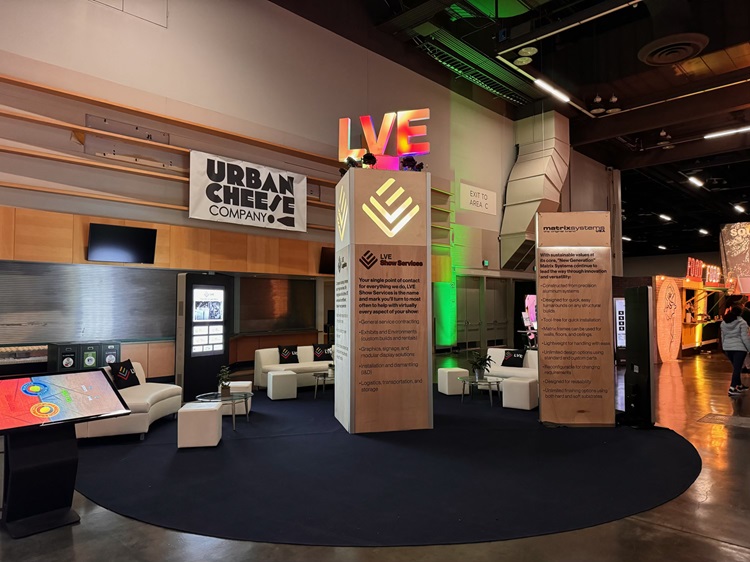In recent years, sustainability has become a focal point for businesses across all industries. As companies look to reduce their environmental impact, even events like trade shows are embracing sustainable practices. A recent tradeshow booth we developed exemplified how sustainability and innovation can go hand-in-hand, resulting in a booth that was not only eco-friendly but also cost-effective. Here’s a closer look at how we implemented sustainable solutions at the event, showcasing both the environmental and financial benefits of these choices.

1. 100% Recyclable Carpet: A Greener Step Underfoot
Traditionally, trade show flooring has been a significant source of waste. As we noted last month there are options out there when it comes to sustainable carpet options however conventional carpeting often ends up in landfills after the event, contributing to the growing issue of waste management. For our booth, we opted for 100% recyclable carpet that could be reused in future shows or repurposed by manufacturers. By choosing a sustainable alternative, we ensured that the materials used for the flooring didn’t have to go to waste, offering a greener alternative to the usual carpet disposal practices.
2. Lightweight, Reusable Matrix Frames
Display frames are a critical part of any tradeshow booth, but their typical construction from non-recyclable materials and weight can make them a less sustainable choice. Our Matrix line of frames are lightweight, flexible in set up, and reusable, because they are made from durable materials that can be easily transported and assembled without significant energy use or waste. These frames were designed to be used repeatedly, further reducing the environmental impact by avoiding the need to produce new materials for each event. In addition, the portability of these frames reduced transportation costs and emissions, providing long-term savings for future tradeshows.
3. Post-Consumer Plywood for Displays
Plywood is often used in tradeshow booths for structural purposes, but sourcing it from sustainable materials is essential. Typically, graphics that go into our Matrix frames are fabric or Sintra. For this show we wanted to not only showcase the flexibility of the Matrix system using other materials, but also a sustainable one. Instead of opting for new wood, we used post-consumer plywood. This material, made from wood that has been recycled and repurposed, minimized the need for new resources. We then laser etched our marketing messages on the wood eliminating the need for printing. After the show, rather than ending up in the dumpster, the plywood was transformed into crates to ship booth materials for future events. By giving this plywood a second life, we were able to close the loop on waste and create reusable shipping materials that will continue to serve their purpose long after the event.
4. Digital Signage: Moving Beyond Paper Printing
Another area where we made a notable impact was in the use of signage. Traditional printed signage often becomes waste at the end of the event, adding to the pile of non-recyclable materials. Instead of using Sintra or fabric, we incorporated digital signage. This technology allowed us to display dynamic, engaging content without any waste. Not only did this solution minimize the carbon footprint of producing and discarding printed materials, but it also offered a more versatile, flexible and cost-effective solution for communicating messages to attendees.
5. Renting vs Owning: A More Sustainable and Cost-Effective Choice
A typical tradeshow booth requires a significant amount of audiovisual (AV) equipment, such as screens, projectors, and microphones. However, purchasing this technology can lead to both high upfront costs and unnecessary waste when the equipment is no longer needed. We chose to rent AV and furniture instead of buying it outright. While cost of rentals can sometimes be high, as a dedicated partner in your business, this can be minimized with the right planning which is a specialty of LVE. This decision reduced our carbon footprint, as rented items are reused across multiple events, while also cutting down on the cost of purchasing and maintaining equipment that would only be used for a limited time.
One of the most striking outcomes of this sustainable approach was the minimal increase in overall costs. While there were slight upfront costs for selecting more eco-friendly materials and renting AV equipment, these expenses were offset by the long-term savings. Reusable materials, digital signage, and rentals will continue to serve multiple purposes across future events, making this approach a sound financial decision. Additionally, by reducing waste and improving efficiency, we contributed to the larger movement toward corporate social responsibility without sacrificing budget.
This approach to sustainable booth design is just one example of how event organizers and exhibitors can create a positive environmental impact. From reducing waste to supporting the reuse of materials, every step counts in making trade shows more sustainable. Companies can enhance their brand reputation by demonstrating a commitment to the environment, all while reducing costs and improving efficiencies.
As the events industry continues to evolve, more and more businesses are likely to follow suit by adopting greener, more sustainable practices. By rethinking traditional booth design and incorporating innovative technologies and materials, we can help your business at tradeshows and events minimize the environmental footprint and pave the way for a more sustainable future.